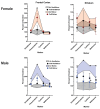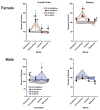The protracted neurotoxic consequences in mice of developmental exposures to inhaled iron nanoparticles alone or in combination with SO2
- PMID: 40786615
- PMCID: PMC12331690
- DOI: 10.3389/fnbeh.2025.1544974
The protracted neurotoxic consequences in mice of developmental exposures to inhaled iron nanoparticles alone or in combination with SO2
Abstract
Introduction: Air pollution (AP) has been associated with increased risk for multiple neurodevelopmental disorders. As one of the most abundant contaminants of AP, iron (Fe) is critical to brain function, with both deficiencies and excesses leading to potential neurotoxicity. Our prior studies examining the impact of developmental exposures of mice to inhaled Fe (1.0 μg/m3) alone or in conjunction with sulfur dioxide SO2 (1.31 mg/m3; FeS) from postnatal days (PND) 4-7 and 10-13 (human 3rd trimester brain equivalent period) revealed alterations in brain neurotransmitter levels at PND14 which had generally recovered by PND60, but which were, nevertheless, followed by behavioral impairments. The current study sought to determine whether subsequent behavioral experience, which requires neurochemical mediation, had unmasked residual deficits in neurotransmitter function in response to developmental FeS or Fe inhalation.
Methods: Consequently, levels of brain neurotransmitters and trans-sulfuration markers were measured in mice that had either behavioral experience (BE) or no behavioral experience (NB) at PND 215 (Fe only) or 357 (FeS).
Results: BE itself markedly increased brain neurotransmitter and trans-sulfuration marker levels, particularly in males. These increases were prevented in males in both frontal cortex and striatum by prior developmental FeS exposures. In females, developmental Fe exposure was associated with residual increases particularly in striatal serotonergic function and levels of homocysteine independently of behavioral experience.
Discussion: Collectively, these findings show the ability of behavioral experience to unmask later life residual consequences of developmental exposures to FeS in males and of latent emerging effects of Fe in females. The collective findings may have relevance to later life neurodegenerative diseases and disorders now increasingly associated with air pollution exposures, and also underscore how understanding how various components of air pollution influence brain is critical to regulatory decisions for public health protection.
Keywords: behavioral experience; brain; dopamine; glutamate; iron; serotonin; sulfur dioxide; trans-sulfuration.
Copyright © 2025 Cory-Slechta, Marvin, Welle, Oberdörster and Sobolewski.
Conflict of interest statement
The authors declare that the research was conducted in the absence of any commercial or financial relationships that could be construed as a potential conflict of interest.
Figures






Similar articles
-
The potential involvement of inhaled iron (Fe) in the neurotoxic effects of ultrafine particulate matter air pollution exposure on brain development in mice.Part Fibre Toxicol. 2022 Aug 9;19(1):56. doi: 10.1186/s12989-022-00496-5. Part Fibre Toxicol. 2022. PMID: 35945578 Free PMC article.
-
Brain iron accumulation in neurodegenerative disorders: Does air pollution play a role?Part Fibre Toxicol. 2025 May 1;22(1):9. doi: 10.1186/s12989-025-00622-z. Part Fibre Toxicol. 2025. PMID: 40312348 Free PMC article.
-
The Black Book of Psychotropic Dosing and Monitoring.Psychopharmacol Bull. 2024 Jul 8;54(3):8-59. Psychopharmacol Bull. 2024. PMID: 38993656 Free PMC article. Review.
-
Male-biased vulnerability of mouse brain tryptophan/kynurenine and glutamate systems to adolescent exposures to concentrated ambient ultrafine particle air pollution.Neurotoxicology. 2024 Sep;104:20-35. doi: 10.1016/j.neuro.2024.07.004. Epub 2024 Jul 11. Neurotoxicology. 2024. PMID: 39002649 Free PMC article.
-
Inhaled mannitol for cystic fibrosis.Cochrane Database Syst Rev. 2018 Feb 9;2(2):CD008649. doi: 10.1002/14651858.CD008649.pub3. Cochrane Database Syst Rev. 2018. Update in: Cochrane Database Syst Rev. 2020 May 1;5:CD008649. doi: 10.1002/14651858.CD008649.pub4. PMID: 29424930 Free PMC article. Updated.
References
-
- Allen J., Liu X., Pelkowski S., Palmer B., Conrad K., Oberdörster G., et al. (2014a). Early postnatal exposure to ultrafine particulate matter air pollution: Persistent ventriculomegaly, neurochemical disruption, and glial activation preferentially in male mice. Environ. Health Perspect. 122 939–945. 10.1289/ehp.1307984 - DOI - PMC - PubMed
-
- Allen J., Liu X., Weston D., Prince L., Oberdörster G., Finkelstein J., et al. (2014b). Developmental exposure to concentrated ambient ultrafine particulate matter air pollution in mice results in persistent and sex-dependent behavioral neurotoxicity and glial activation. Toxicol. Sci. 140 160–178. 10.1093/toxsci/kfu059 - DOI - PMC - PubMed
-
- Allen J., Oberdorster G., Morris-Schaffer K., Wong C., Klocke C., Sobolewski M., et al. (2015). Developmental neurotoxicity of inhaled ambient ultrafine particle air pollution: Parallels with neuropathological and behavioral features of autism and other neurodevelopmental disorders. Neurotoxicology 59 140–154. 10.1016/j.neuro.2015.12.014 - DOI - PMC - PubMed
LinkOut - more resources
Full Text Sources
Research Materials
Miscellaneous

